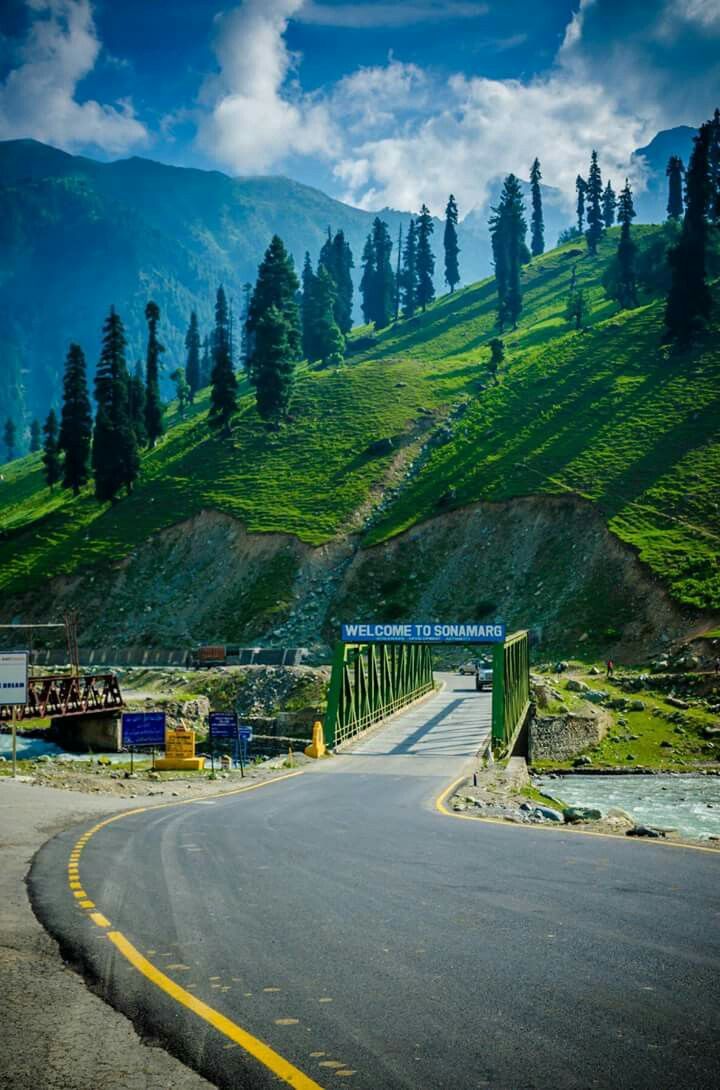Sonmarg

Sonmarg, Jammu and Kashmir. India
Sonmarg, sometimes known as "Sonamarg" (meaning "Meadow of Gold"), is a picturesque hill station and famous tourist attraction in the Indian-administered state of Jammu and Kashmir. It is located in northern India, some 80 kilometres (50 miles) from Srinagar, Jammu and Kashmir's summer capital. This lovely location is known for its breathtaking scenery, lush meadows, snow-capped mountains, and glacial streams.
Here's a detailed look of Sonmarg, including its topography, sights, activities, and travel information.
1. Geography and Location.
Sonmarg is approximately 2,800 meters (9,186 ft) above sea level.
Region: It is located in the Ganderbal district of Jammu and Kashmir, near the Sindh River, which contributes to the area's attractiveness.
Access: Sonmarg is along theThe Srinagar-Leh Highway connects Srinagar and Leh and is a key route for travellers coming to Leh in Ladakh. The hamlet also serves as a base camp for trekkers and adventurers travelling to other sites in the area, including the Amarnath Yatra.
2. Natural Beauty.
Meadows and Valleys: Sonmarg is famed for its lush green meadows, which turn gold in the summer, hence the name "Sonamarg." The meadows are flanked by high snow-covered mountains, creating a quiet and tranquil environment.
Glaciers: The Thajiwas Glacier, one of the most prominent glaciers near Sonmarg, is a major attraction. It is located approximately 5 kilometres from the town and can be approached on foot, by horse, or in avehicle.
Mountains: The neighbouring summits, particularly the gigantic Kolhoi Peak, are popular with mountaineers. The location provides stunning vistas of rough landscapes and high-altitude hills.
Sindh River: The river that runs through town is noted for its crystal-clear waters and is ideal for a picturesque walk or a quiet sit beside its banks.
3. Top attractions
Thajiwas glacier: The Thajiwas Glacier is a must-see for adventurers, offering trekking opportunities as well as a breathtaking vista of snow-capped peaks. During the summer, visitors can take horse rides up to the glacier.
Krishansar and Gadsar Lakes: These high-altitude alpine lakes are accessible via walking and are flanked by rough mountains and wildflowers. Treks to these lakes are popular among adventurers.
Sonmarg Meadows: The vast meadows are theThe ideal setting for a picnic, a hike, or simply admiring the snow-covered peaks and meandering streams.
Sonmarg Pass: A mountain pass that connects to the Kashmir Valley and is part of the broader trek to the Amarnath Cave, a Hindu religious place.
Sheshnag Lake is a beautiful, calm lake surrounded by forests and snow-covered peaks, known for its crystal-clear water.
4. Activities and Adventures.
Trekking & Hiking: Sonmarg serves as a base for various treks, including those to Krishansar Lake, Gadsar Lake, and the Amarnath Yatra route. The routes range from easy to difficult, providing something for every level of adventurer.
Camping: The extensive fields near Sonmarg are ideal for camping. Travellers frequently set up tents in the picturesque surroundingsEnjoy the natural splendour and the stars at night.
Fishing: The Sindh River provides excellent prospects for trout fishing, particularly in its pure waters.
Horse Riding: Horse rides are provided to many significant spots, including Thajiwas Glacier, and are a popular method for non-trekkers to experience the environs.
Photography and Sightseeing: The region's scenery, fauna, and pristine beauty make it a photographer's dream. There are various vantage spots that provide breathtaking views of the valleys, mountains, and lakes.
5. Cultural Significance.
Religious Importance: Sonmarg is also a stopover for people embarking on the Amarnath Yatra, a well-known pilgrimage to the Amarnath Cave among Hindus. The town is a significant stopping point for pilgrims travelling to the shrine.
Historical Context: Sonmarg'sThe past is inextricably linked to its placement along the old trade routes between Kashmir and Ladakh. The region has been known to travellers for generations, and its picturesque splendour has always drawn people from all over the world.
6. The best time to visit Sonmarg is during the summer (April-October). The weather in these months is nice, with temperatures ranging from 15°C to 25°C (59°F to 77°F). The meadows are lush and verdant, perfect for hiking, camping, and sightseeing.
Winter (November-March): The winters in Sonmarg are cold and harsh, with considerable snowfall. The region frequently suffers low temperatures, and the scenery is covered in snow, making it a wonderful destination for winter sports and a tranquilretreat. However, travel may be difficult owing to the snow, so it is critical to verify road conditions before making a journey.
7. Travel Tips.
Transportation: Srinagar is the nearest major city to Sonmarg. Sonmarg is approximately 2 to 3 hours away by vehicle from there. Taxis, buses, and private vehicles are the most popular types of transportation. Snowfall can cause roadblocks throughout the winter months, thus it is recommended that you monitor weather reports and road conditions.
Sonmarg offers a variety of accommodation options, including guesthouses, hotels, and luxury resorts. It can get crowded during peak season (summer), so it's best to book in advance.
Sonmarg is a relatively secure area, however it's crucial to take the proper measures whether trekking or exploring into Remote places are subject to unpredictable weather conditions. Travellers should be prepared for temperature changes and pack appropriate gear for their activity.
